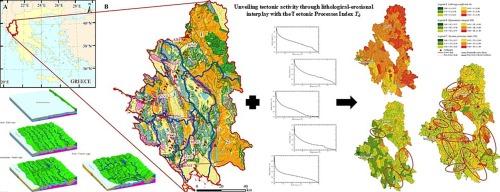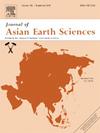通过Τectonic过程指数Tδ揭示岩性-侵蚀相互作用的构造活动
IF 2.4
3区 地球科学
Q2 GEOSCIENCES, MULTIDISCIPLINARY
引用次数: 0
摘要
确定易受地震影响的地区对于减轻地震危害至关重要。构造过程指数(Tδ)是一种整合了岩性(δ)的新型形态构造指数,旨在加强构造活动性和地震危险性的评价。传统的指数,如半对称积分(HI)在以可蚀性岩性为主的地区可能受到限制。虽然HI同时考虑了构造和侵蚀的影响,但它往往不能完全反映复杂地质条件下的盆地演化。Tδ通过明确地结合构造力、侵蚀模式和岩性变异性之间的相互作用来解决这一限制。这种综合方法对盆地发育及其构造意义有了更详细的认识。在希腊西北部地质环境多样化地区的应用证明了Tδ的有效性。通过与构造图、地震活动记录和常规形态构造指数的对比分析,进一步支持了Tδ的有效性,证实了其在捕捉活动构造过程中的稳健性。Tδ能可靠地区分静止盆地和受新构造变形影响的盆地。与传统方法相比,它在识别构造活动区方面提供了更高的分辨率。除了地震灾害评估之外,Tδ还具有为地震敏感地区的土地利用规划提供信息和支持地质资源管理的潜力。本文章由计算机程序翻译,如有差异,请以英文原文为准。

Unveiling tectonic activity through lithological-erosional interplay with the Τectonic Processes Index Tδ
Identifying regions susceptible to earthquakes is crucial for mitigating seismic hazards. This study introduces the Tectonic Processes Index (Tδ), a novel morphotectonic index that integrates lithology (δ) to enhance the assessment of tectonic activity and seismic hazards. Traditional indices such as the Hypsometric Integral (HI) can be limited in areas dominated by erodible lithologies. While HI accounts for both tectonic and erosional influences, it often fails to fully capture basin evolution under complex geological conditions. Tδ addresses this limitation by explicitly incorporating the interaction between tectonic forces, erosional patterns, and lithological variability. This comprehensive approach offers a more detailed understanding of basin development and its tectonic significance. Application in northwestern Greece—a region with diverse geological settings—demonstrates the Tδ’s effectiveness. The validity of Tδ is further supported through comparative analysis with mapped tectonic structures, seismicity records, and conventional morphotectonic indices, confirming its robustness in capturing active tectonic processes. Tδ reliably distinguishes quiescent basins from those affected by neotectonic deformation. Compared to traditional methods, it offers improved resolution in identifying tectonically active areas. Beyond seismic hazard assessment, Tδ has the potential to inform land-use planning and support geological resource management in seismically sensitive regions.
求助全文
通过发布文献求助,成功后即可免费获取论文全文。
去求助
来源期刊

Journal of Asian Earth Sciences
地学-地球科学综合
CiteScore
5.90
自引率
10.00%
发文量
324
审稿时长
71 days
期刊介绍:
Journal of Asian Earth Sciences has an open access mirror journal Journal of Asian Earth Sciences: X, sharing the same aims and scope, editorial team, submission system and rigorous peer review.
The Journal of Asian Earth Sciences is an international interdisciplinary journal devoted to all aspects of research related to the solid Earth Sciences of Asia. The Journal publishes high quality, peer-reviewed scientific papers on the regional geology, tectonics, geochemistry and geophysics of Asia. It will be devoted primarily to research papers but short communications relating to new developments of broad interest, reviews and book reviews will also be included. Papers must have international appeal and should present work of more than local significance.
The scope includes deep processes of the Asian continent and its adjacent oceans; seismology and earthquakes; orogeny, magmatism, metamorphism and volcanism; growth, deformation and destruction of the Asian crust; crust-mantle interaction; evolution of life (early life, biostratigraphy, biogeography and mass-extinction); fluids, fluxes and reservoirs of mineral and energy resources; surface processes (weathering, erosion, transport and deposition of sediments) and resulting geomorphology; and the response of the Earth to global climate change as viewed within the Asian continent and surrounding oceans.
 求助内容:
求助内容: 应助结果提醒方式:
应助结果提醒方式:


